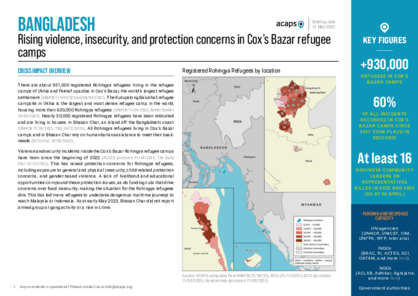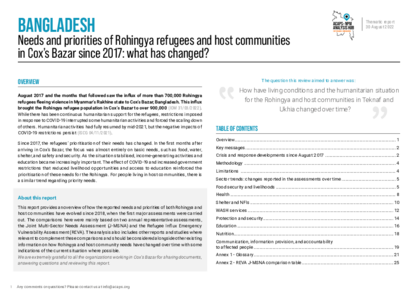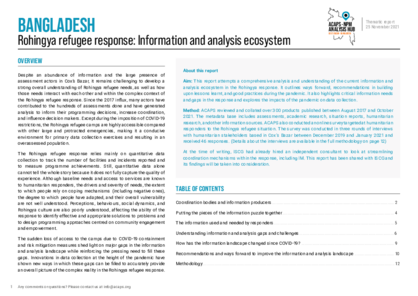
ACAPS collaborated and established an Analysis Hub in Cox’s Bazar with IOM’s Needs and Population Monitoring project from December 2017 to December 2022. This Analysis Hub provided analytical briefs in support of operational responders, which involved looking at primary data, conducting secondary data reviews, and discussing with key stakeholders on different themes.
Bangladesh has been receiving waves of Rohingya refugees since 1978. The most recent influx occurred in September 2017, when over 700,000 Rohingya crossed the border into Bangladesh after fleeing a military campaign in Rakhine state. As at December 2022, there was no agreement on returns.
For five years, the Hub provided stakeholders with an overview of the situation in Cox’s Bazar through regular updates and specialised thematic products. Regular updates came in the form of ACAPS-designed overview products and combinations of stakeholder requests and initiations of the Hub.
The Rohingya population in Cox’s Bazar lives in a protracted crisis and is entirely dependent on humanitarian assistance. Camp conditions are marked by insecurity, congestion, lack of privacy, and inadequate sanitation facilities and water infrastructure.
strengthening gender analysis
From 2018–2022, the Analysis Hub in Cox’s Bazar looked at ways in which the analysis of gender issues among the Rohingya and host communities could support improved gender-sensitive humanitarian programming. In 2020, ACAPS provided Rapid Gender Assessment support to Gender in Humanitarian Action (GiHA).
"This is really important research work for anybody seeking to improve response. The findings are unsurprising for anybody who's worked on needs assessment or statistical analysis, but having it set out so clearly is extremely valuable."
Analysis products
on
Rohingya crisis
12 May 2023
Rising violence, insecurity, and protection concerns in Cox’s Bazar refugee camps
DOCUMENT / PDF / 744 KB
There are about 931,000 registered Rohingya refugees living in the camps of Ukhia and Teknaf upazilas in Cox’s Bazar. Nearly 30,000 registered Rohingya refugees have been relocated and are living in houses in Bhasan Char, an island off the Bangladeshi coast.
Attached resources
30 August 2022
Needs of Rohingya refugees and host communities in Cox's Bazar since 2017
DOCUMENT / PDF / 1 MB
This report provides an overview of how the reported needs and priorities of both Rohingya and host communities have evolved since 2018, when the first major assessments were carried out. The comparisons here were mainly based on two annual representative assessments, the Joint Multi-Sector Needs Assessment and the Refugee Influx Emergency Vulnerability Assessment.
22 April 2022
Protection implications of polygamous marriages in the Rohingya camps
DOCUMENT / PDF / 838 KB
This report explores the reasons behind the increasing practice of polygamy and the protection implications of polygamous marriages in the Rohingya camps. It also analyses reports of increasing intercommunity polygamy between the Rohingya and the adjacent host community, potentially raising additional protection concerns different from existing intracommunity protection concerns.
07 March 2022
Gaps in gender research in the Rohingya refugee response
DOCUMENT / PDF / 298 KB
This report provides a specific understanding of gendered needs and explore how these needs intersect with other dimensions, such as age, disability, social status, education, income, legal status, and religion. But despite the developments, several gaps in understanding shifts in gender norms and practices in the Rohingya community and their impact on specific populations still exist.
25 November 2021
Information and analysis ecosystem in the Rohingya refugee response
DOCUMENT / PDF / 872 KB
This report attempts a comprehensive analysis and understanding of the current information and analysis ecosystem in the Rohingya response. It outlines ways forward, recommendations in building upon lessons learnt, and good practices during the pandemic. It also highlights critical information needs and gaps in the response and explores the impacts of the pandemic on data collection.
Related content
Good practices
Collecting data in the Rohingya camps in Cox’s bazar
What has worked based on five years of collective experience
Technical note
Challenges in analysing needs over time
An analysis based on Multi-Sectoral Needs Assessments (MSNAs) and experiences from the Rohingya response







